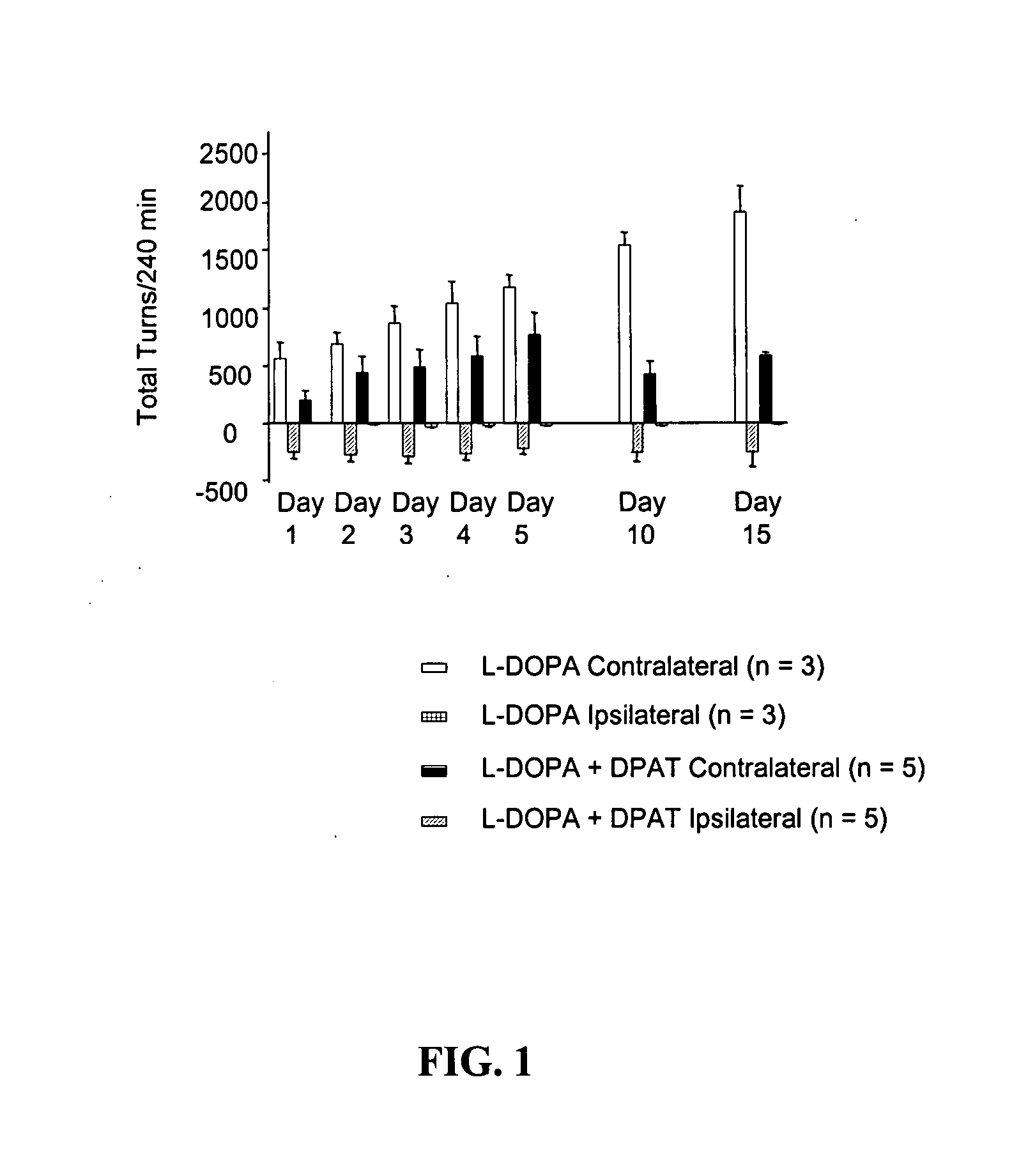Pharmacological treatment of parkinson's disease
a parkinson's disease and drug technology, applied in the field of parkinson's disease drug therapy, can solve the problems of debilitating side effects, severe nausea, vomiting, psychosis, and patients' frequent side effects, and achieve the effects of reducing at least one symptom, and reducing at least one side effect of dopamine receptor agonis
- Summary
- Abstract
- Description
- Claims
- Application Information
AI Technical Summary
Benefits of technology
Problems solved by technology
Method used
Image
Examples
example 1
Motor Effects of Co-Administration of a Serotonin Agonist and L-DOPA in a Rat Model of Parkinson's Disease
[0052] Preparation of hemi-lesioned 6-hydroxydopamine (6-OHDA)-treated rat model of Parkinson 's disease. Rats were rendered parkinsonian on one side of the brain by unilateral destruction of nigrostriatal dopamine neurons using the selective neurotoxin 6-OHDA and stereotaxic procedures. Animals were allowed to recover for at least 2 weeks following this procedure. Animals were then screened for efficacy of the lesion by subcutaneous injection of L-DOPA (25 mg / kg) plus the decarboxylase inhibitor benserazide (6.25 mg / kg) followed by assessment of motor activity.
[0053] Assessment of motor activity. Anti-parkinsonian action in the hemi-lesioned 6-OHDA-treated rat model was assessed by the elicitation of rotational activity to the side opposite the lesioned hemisphere (contralateral turns) following drug treatment. The number of contralateral turns was assessed by videotape recor...
example 3
The Anti-Parkinsonian Effect of a Serotonin Agonist Requires Repeated Administration
[0058] Repeated Administration of a 5-HT1A Agonist. The methods described in the previous examples were used to examine the effects of acute and chronic administration of the 5-HT1A agonist, R(+)-8-OHDPAT. The dose of both R(+)-8-OHDPAT and SKF 38393 was 0.3 mg / kg throughout this experiment. FIG. 4 graphically depicts the results of an experiment in which animals received either a) 14 days of R(+)-8-OHDPAT followed by SKF 38393 plus vehicle on test day, b) 14 days of R(+)-8-OHDPAT followed by SKF 38393 plus R(+)-8-OHDPAT on test day, c) 14 days of vehicle followed by SKF 38393 plus vehicle on test day, or d) 14 days of vehicle followed by SKF 38393 plus R(+)-8-OHDPAT on test day. Animals that received 14 day pretreatment with R(+)-8-OHDPAT plus concomitant R(+)-8-OHDPAT +SKF 38393 on test day exhibited significant anti-parkinsonian action greater than all other treatment groups (p<0.001). These data...
example 4
A Serotonin Agonist Reduces Dyskinetic Behavior Elicited by Moderate Doses of Dopamine Agonists
[0061] The experiments described in this example were conducted as described above. A dyskinesia index for each animal was determined during a 3 hr rotational test. FIG. 5 illustrates that repeated R(+)-8-OHDPAT administration reduced dyskinetic behavior elicited by a moderately high dose of SKF 38393 (3.0 mg / kg). Similarly, FIG. 6 illustrates that repeated R(+)-8-OHDPAT administration reduced dyskinetic behavior elicited by quinpirole (0.05 mg / kg).
PUM
| Property | Measurement | Unit |
|---|---|---|
| Current | aaaaa | aaaaa |
| Stiffness | aaaaa | aaaaa |
Abstract
Description
Claims
Application Information
 Login to View More
Login to View More - R&D
- Intellectual Property
- Life Sciences
- Materials
- Tech Scout
- Unparalleled Data Quality
- Higher Quality Content
- 60% Fewer Hallucinations
Browse by: Latest US Patents, China's latest patents, Technical Efficacy Thesaurus, Application Domain, Technology Topic, Popular Technical Reports.
© 2025 PatSnap. All rights reserved.Legal|Privacy policy|Modern Slavery Act Transparency Statement|Sitemap|About US| Contact US: help@patsnap.com



